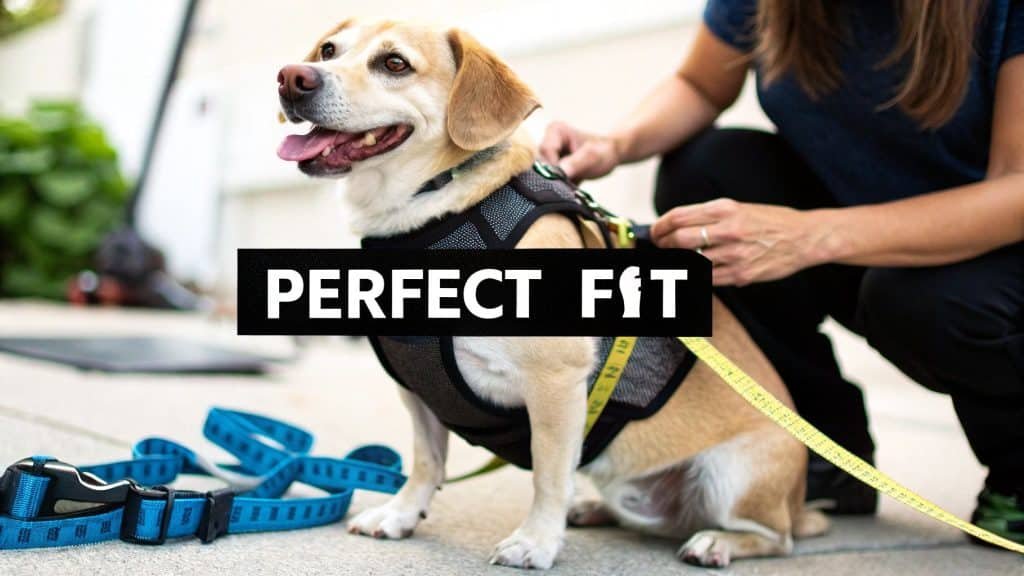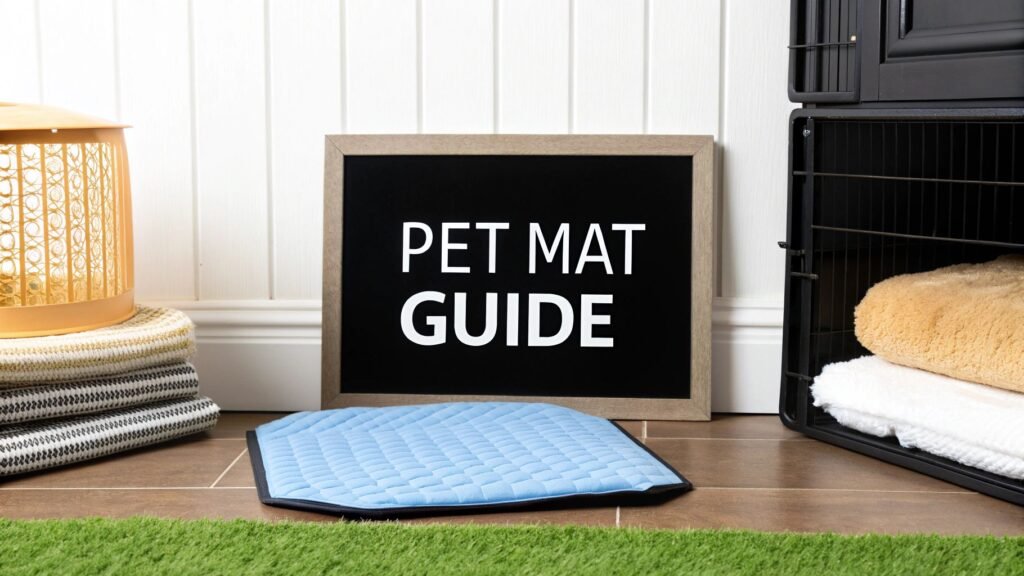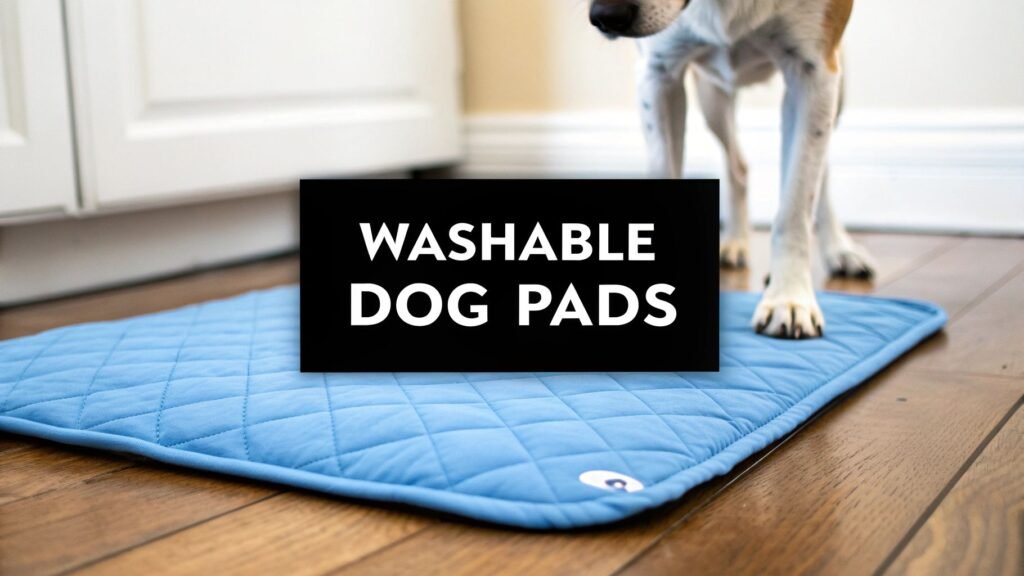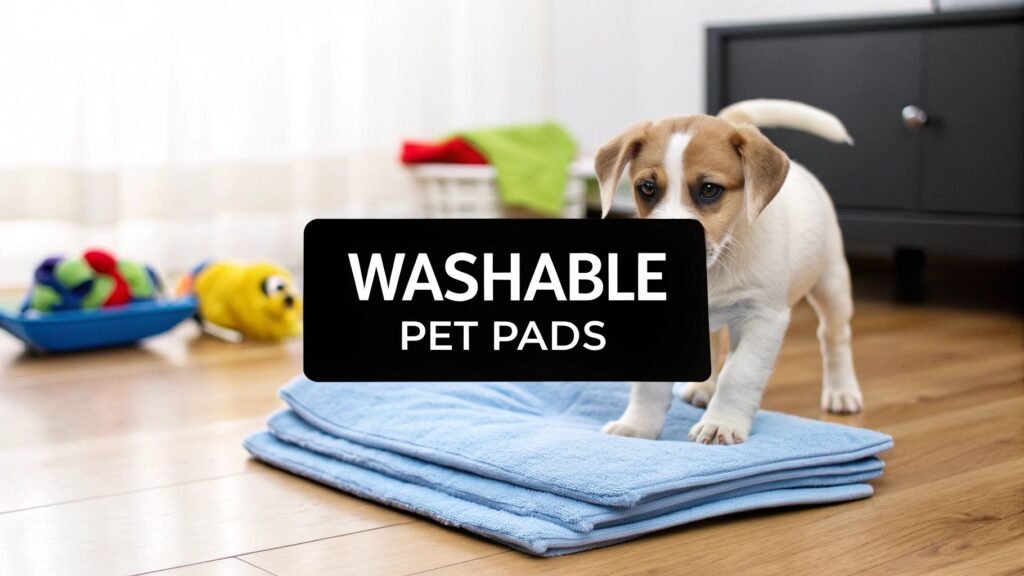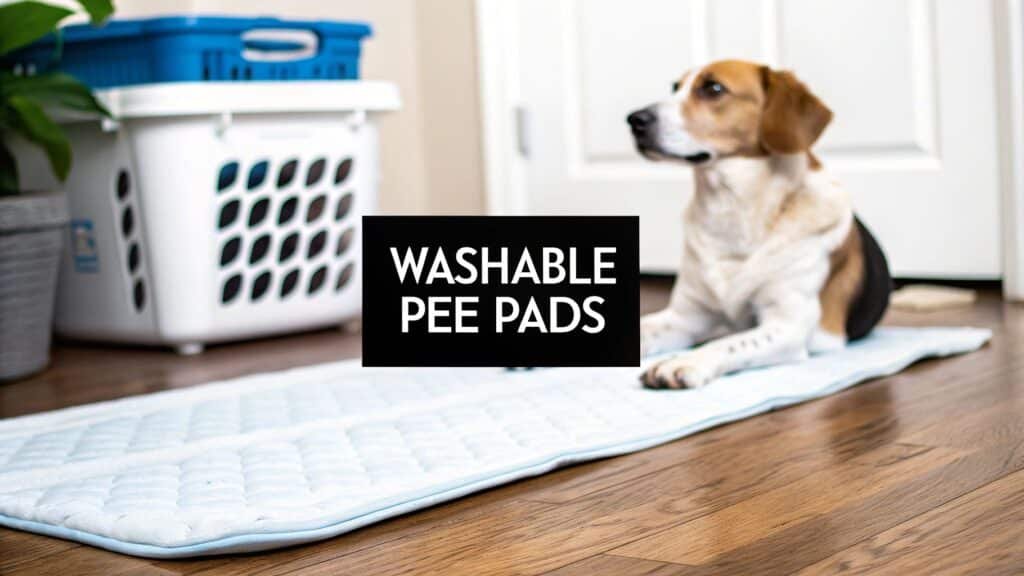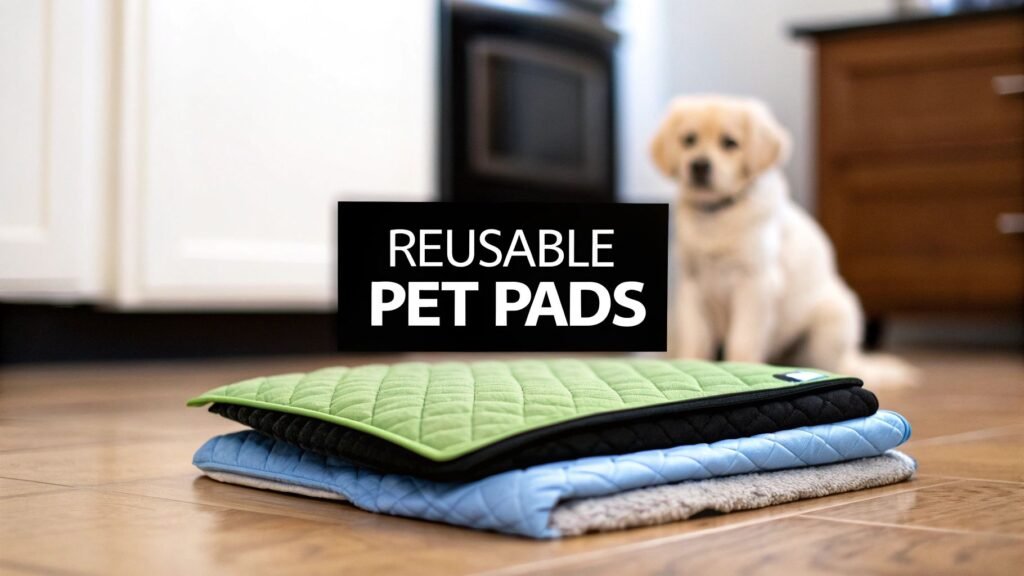Best Pet Washable Pee Pads: Comfortable & Eco-Friendly Choice
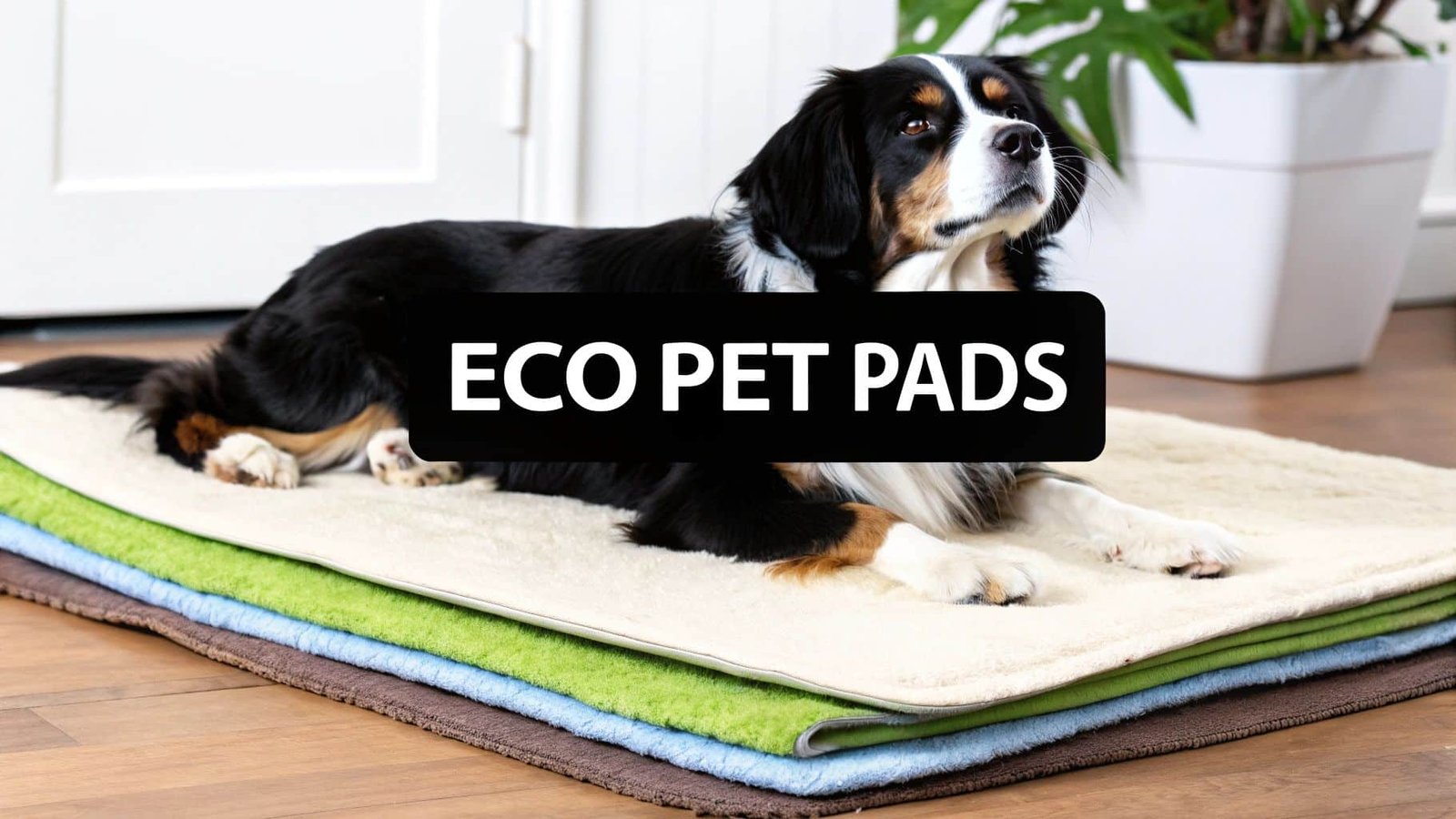
Pet washable pee pads are a game-changer for so many pet owners. Think of them as a modern, reusable, and much more eco-friendly version of the classic disposable pads. They’re designed with multiple layers for serious absorbency and have a waterproof backing to keep your floors safe and dry. It’s a smart, one-time investment that pays off for years.
The Modern Shift to Reusable Pet Pads
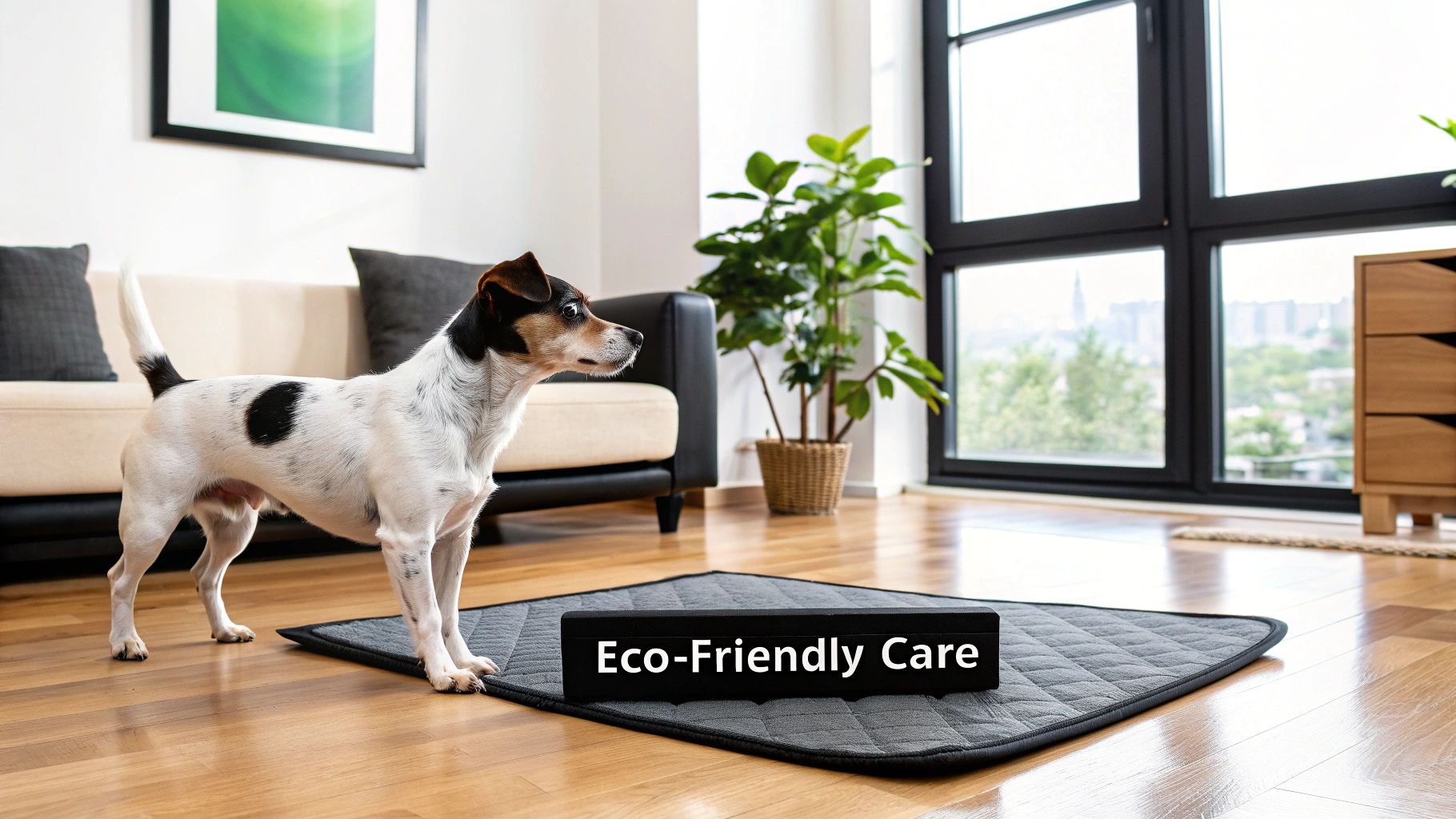
For a long time, the only real choice for handling indoor pet accidents was a stack of disposable pads. It was a simple solution, sure, but it locked pet owners into a constant cycle of buying, using, and tossing. This meant endless spending and a mountain of trash heading to landfills.
But now, things are changing. Smart pet parents are catching on to the massive benefits of pet washable pee pads, and a real shift is happening.
This isn’t just about a new product—it’s about a whole new way of thinking about pet care. Instead of literally throwing your money in the trash with every used pad, you make a single purchase for a durable, high-quality solution that can last for years. It’s a conscious choice for sustainability, better home protection, and frankly, a more efficient way to manage pet life.
Why Pet Owners Are Making the Switch
The reasons for ditching disposables are pretty hard to ignore. People are getting fed up with the never-ending expense and the environmental footprint of single-use pads. Washable pads solve these problems head-on, and they often work even better.
Here’s a quick look at what’s driving this change:
- Serious Long-Term Savings: Once you buy a few washable pads, your recurring costs drop to almost zero. We’re talking about saving hundreds of dollars over the life of your pet.
- A Huge Reduction in Waste: A single washable pad can take the place of hundreds, sometimes even thousands, of disposables. That’s a massive amount of plastic and waste that won’t end up in a landfill.
- They Just Work Better: Top-notch washable pads are incredibly absorbent, offer tougher leak protection, and usually have a non-slip backing to keep them from sliding all over the floor.
- Way More Comfortable for Your Pet: The top layer is soft and fabric-like, which is much more inviting for a dog or puppy to relax on compared to the crinkly, papery feel of a disposable.
This isn’t just a niche trend; it’s a significant market shift. The global market for washable pet pee pads was valued at around USD 245 million in 2023. Projections show it soaring to USD 412 million by 2033, a clear sign that pet owners are voting with their wallets for more sustainable options.
Washable vs. Disposable Pads at a Glance
To make it even clearer, let’s break down the key differences. This table gives you a quick snapshot of why so many people are making the move to washable pads.
| Feature | Washable Pee Pads | Disposable Pee Pads |
|---|---|---|
| Cost | Higher initial cost, but very low long-term cost. | Low initial cost, but high ongoing cost. |
| Environmental Impact | Eco-friendly. Drastically reduces landfill waste. | High environmental impact. Creates tons of waste. |
| Durability | Excellent. Lasts for hundreds of washes. | Single-use. Easily torn or shredded. |
| Absorbency | Very high. Multiple layers lock in moisture. | Varies, but often less absorbent than quality reusables. |
| Leak Protection | Superior. Features a fully waterproof backing. | Prone to leaks, especially with larger messes. |
| Comfort | Soft and comfortable fabric top. | Crinkly, paper-like surface. |
As you can see, while disposables offer a bit of convenience upfront, washable pads win out in almost every other category, especially when you think about the long run.
Breaking the Disposable Cycle
The entire business model for disposable pads is built around you having to buy them over and over again. It’s a constant drain on your bank account. An average dog can easily go through hundreds of pads in a single year, and that cost adds up faster than you’d think. Not to mention the environmental toll of all that waste.
Choosing pet washable pee pads is how you break free from that expensive, wasteful cycle. It’s a decision that aligns your pet care routine with being financially smart and environmentally responsible. You’re not just buying another pet product; you’re adopting a better, more sustainable lifestyle with your furry friend.
To dive even deeper into this, check out our detailed breakdown of reusable dog pee pads vs disposable pads. It’s a great resource that really lays out why making the switch is the best move for both your wallet and the planet.
How Washable Pee Pads Are Engineered
The magic behind a great pet washable pee pad isn’t magic at all—it’s just smart engineering. A good way to think about it is to compare it to modern athletic gear. A high-tech running shirt isn’t just a single piece of cloth; it’s a layered system designed to pull sweat away from your skin, keep you dry, and still feel breathable. Washable pee pads use that same layering principle to manage moisture, trap odors, and ultimately, protect your home.
This clever construction means that even when the surface feels soft and dry for your pet, any liquid gets pulled deep inside and locked away. It’s what stops messes from spreading and prevents your pup from tracking wet paw prints all over the house. Each layer has a very specific job to do.
The Multi-Layer Defense System
At its heart, a washable pee pad is a “sandwich” of specialized fabrics. Each one is chosen for a specific property, and together they create a system that’s leak-proof, comfortable, and far more durable than an old towel or blanket could ever be.
- Top Layer (Moisture-Wicking): This is the part your pet actually touches. It’s usually a soft, often quilted, fabric designed to instantly pull urine down and away from the surface. This keeps your pet’s fur and paws from getting soaked.
- Inner Core (Super Absorbent): Here’s the powerhouse of the pad. This is an ultra-absorbent layer, typically made from a high-tech microfiber or a specialized soaker blend, that can hold an incredible amount of liquid—many times its own weight. This is also where odor neutralization happens.
- Backing Layer (Waterproof & Non-Slip): The final line of defense is a totally waterproof barrier, often made from polyurethane (TPU). This layer is what guarantees absolutely no liquid will seep through to your floors. Many pads also feature non-slip dots on this backing to keep it from sliding around.
This infographic gives you a great cross-section view of how these durable layers work together to protect your floors.
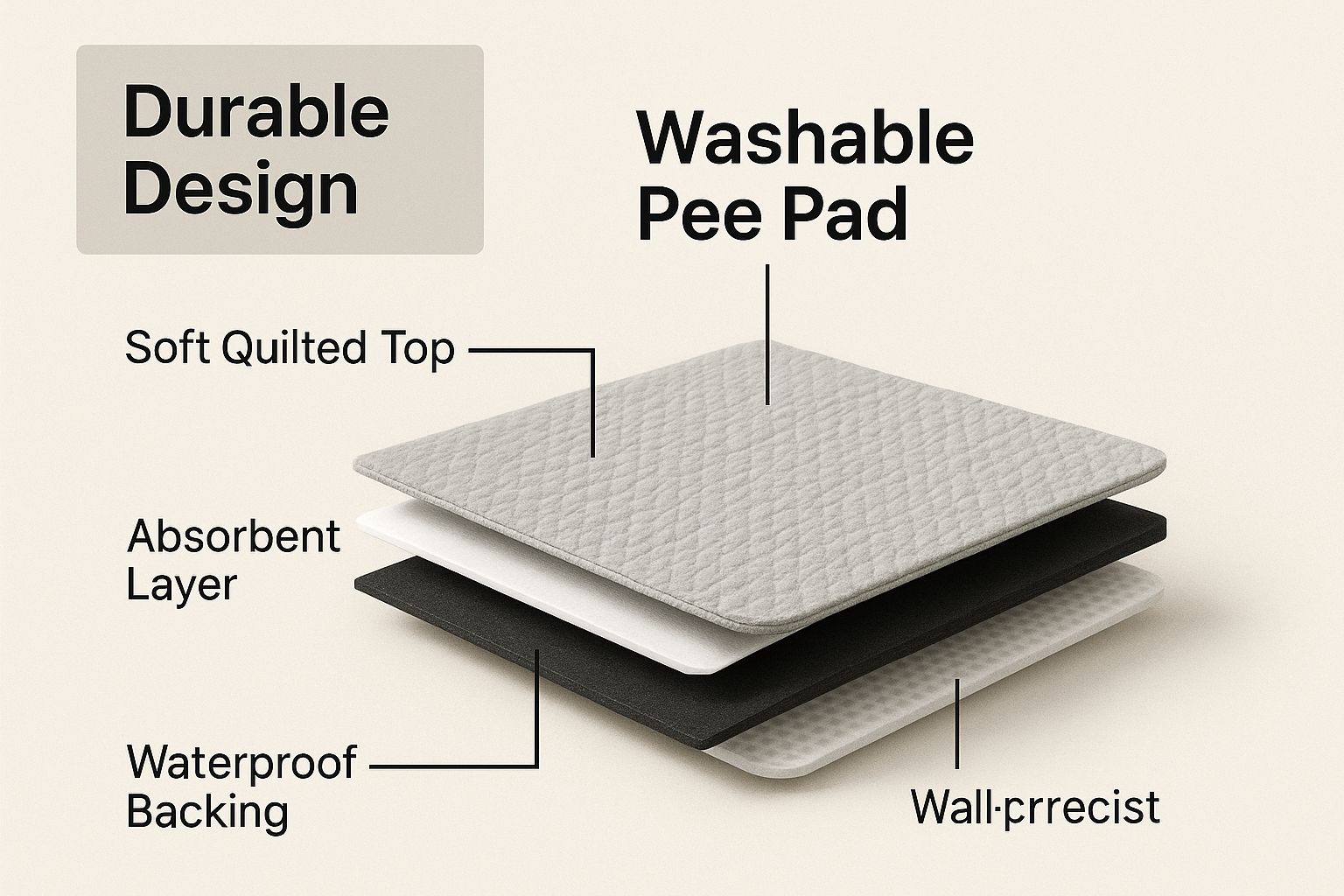
As you can see, the pad’s effectiveness comes from this coordinated effort, not just one single material.
Materials Built for Durability
The choice of materials is what really separates a premium, long-lasting pad from a flimsy one that fails after a few washes. The fabrics have to be both high-performance and tough enough to withstand constant use and hundreds of trips through the laundry. This is where a little materials science makes a huge difference.
Top-tier pads use advanced microfibers for their absorbent cores. These fibers are incredibly fine, which creates a huge amount of surface area to soak up liquid fast. Unlike plain old cotton, which gets saturated and takes forever to dry, microfiber locks moisture deep within its structure, keeping it from seeping back up to the surface.
The waterproof backing is most often a thermoplastic polyurethane (TPU) laminate. This stuff is fantastic because it’s 100% waterproof but also flexible and breathable, so you don’t get that awful crinkling sound you hear with cheap plastics. Most importantly, it’s designed to handle the high heat of washing and drying without cracking or falling apart.
This heavy-duty construction is why a single, well-made washable pad can survive hundreds of wash cycles. In fact, studies on fabric durability show that high-quality polyurethane laminates can keep their waterproof integrity for over 300 washes. This ensures your investment is protected and your floors stay safe for years. When you choose a properly engineered pad, you’re not just buying a piece of fabric; you’re getting a reliable tool designed for serious, long-term performance.
How to Choose the Right Washable Pad
Picking the right pet washable pee pads is about more than just finding a color you like. Think of it like buying a good raincoat—a cheap poncho might work in a drizzle, but it won’t hold up in a real storm. You need the right size, the right materials, and the right features for your specific dog and your home.
Making a smart choice here really does affect your day-to-day life and your pet’s comfort. A pad that’s too small for your Great Dane is going to mean constant, frustrating overflows. On the other hand, a flimsy pad won’t do much for a puppy you have to leave alone for a few hours. Let’s break down what actually matters.
Match the Pad Size to Your Pet
Honestly, the biggest mistake I see people make is buying a pad that’s too small. Your dog needs enough room to walk on, do a little circle, and find the perfect spot without a paw hanging off the edge. This is a huge deal for puppies who are still getting their bearings and for older dogs who might not have the best aim anymore.
Here’s a simple way to think about it:
- Small Dogs & Puppies (under 25 lbs): A standard 24″ x 36″ pad usually does the trick. It gives them plenty of space without taking over your entire living room.
- Medium to Large Dogs (25-70 lbs): You’ve got to go bigger. Look for something in the 48″ x 48″ range or even larger. You want to avoid those “close but not quite” accidents right on the border.
- Extra-Large Breeds or Multiple Dogs: Don’t be shy about getting the biggest pad you can find. Sometimes they’re sold as whelping pads, and they’re fantastic for creating a large, can’t-miss target.
A well-sized pad is your best defense. And if you need to protect furniture or your car, you can find other great pet mats and beds designed for those tricky spots.
Understand Absorbency and Materials
Not all pads are created equal when it comes to soaking power. How much absorbency you need really depends on your dog’s size, age, and how long they’ll be on their own. A good pad will actually tell you how much liquid it can hold, usually in ounces or cups, which takes a lot of the guesswork out of it.
The materials are key, too—they dictate everything from absorbency to odor control. Look for a soft, quilted top layer that wicks moisture away fast so your pet isn’t tracking wet paw prints all over the house. The magic happens in the inner core, which is usually a super-dense poly-rayon blend that traps liquid and keeps smells locked in. And most importantly, a waterproof TPU backing ensures nothing ever seeps through to your precious floors.
Key Takeaway: Always aim for a pad that can hold more liquid than you think you need. It’s like an insurance policy for those days you get stuck in traffic, ensuring your floors stay safe and dry no matter what.
Prioritize Durability and Safety Features
The best washable pads are built like tanks—they’re designed to withstand hundreds of trips through the washing machine. You can spot a quality pad by looking for a few key details.
- Reinforced Stitching: Take a look at the edges. Strong, clean stitching is a sign that the layers won’t separate or fray after a few washes.
- Non-Slip Backing: This is a non-negotiable safety feature. Little rubber dots on the bottom keep the pad from sliding around on hardwood, tile, or laminate floors. It’s crucial for preventing slips and keeping the pad right where you put it.
- Odor Control Technology: Some of the better pads use materials that are specifically engineered to trap and neutralize ammonia odors. This makes a huge difference in keeping your home smelling fresh between laundry days.
These details might seem small, but they add up to a pad that’s easy and reliable to use every day. More and more pet owners are catching on, which is why the demand for high-quality reusable pads is booming. In fact, you can see from market trends for washable pet pads that people in North America and Europe are ditching disposables for more sustainable, effective options.
Choosing the right pad isn’t just about cleaning up messes—it’s about finding a solution that fits seamlessly into your life. The table below can help you zero in on the features that will matter most for your unique furry friend.
Pad Features for Every Pet Life Stage
| Consideration | Best For Small Dogs / Puppies | Best For Large Dogs | Best For Senior Dogs |
|---|---|---|---|
| Size | Standard (24″x36″) is often fine. | Larger is better (48″x48″+). A big target prevents edge misses. | Large and easy to spot. Consider multiple pads in key areas. |
| Absorbency | Medium to high, as they may have frequent small accidents. | High to extra-high capacity to handle larger volumes of liquid. | Extra-high absorbency for potential incontinence issues. |
| Grip | Essential! A non-slip backing prevents sliding during playful pounces. | A strong non-slip grip is crucial to keep the pad in place under their weight. | Top priority. A stable surface prevents slips for less mobile dogs. |
| Durability | Important. Look for strong stitching to survive frequent washing. | Critical. Reinforced edges will withstand a heavier dog’s use. | Very important. Needs to hold up to very frequent washing cycles. |
At the end of the day, matching the pad’s features to your dog’s stage of life makes all the difference between a helpful tool and a daily frustration.
Getting the Hang of Your Washable Pad Routine
Bringing home a set of pet washable pee pads is a great move. But the real magic happens when you nail down a simple, consistent routine for using and cleaning them. Think of it like meal prepping—a little effort up front makes the rest of the week a breeze. A good system keeps your pads clean, absorbent, and odor-free for the long haul.
The idea isn’t to add a complicated chore to your list. It’s about creating a straightforward process that makes managing your pads feel almost automatic. From the first introduction to the final spin cycle, mastering these few steps will show you just how convenient these pads really are.
Getting Your Pet on Board
A smooth transition to a washable pad starts with a friendly introduction. Don’t just toss it on the floor and hope for the best. You want to make it an inviting and familiar part of their world.
To make the switch from disposables seamless, give this little trick a try:
- Lay Out the New Pad: Place the fresh, clean washable pad in your pet’s usual potty spot.
- Add a Scent Marker: Put a lightly used disposable pad right on top of the new one. Just a small spot of urine is all you need. This transfers their scent, letting them know this new fabric is an approved place to go.
- Remove the Disposable: After a few hours or overnight, take the disposable pad away. The scent will linger, encouraging your pet to use the washable pad.
- Celebrate Success!: The moment they use the new pad correctly, shower them with praise and a favorite treat. Positive reinforcement is everything when you’re building a new habit.
This method connects the new pad to their old habits, so the change feels completely natural. Just be consistent and keep those rewards coming!
The Simple Step-by-Step Cleaning Process
Keeping your pads in top shape is easy once you have a solid washing routine. The right technique doesn’t just get them clean; it protects the pad’s high-tech materials, preserving the absorbent core and waterproof backing for hundreds of washes. If you start cutting corners, you’ll end up with lingering smells or pads that just don’t work as well.
Here’s your laundry playbook for perfect results every time:
- Pre-Rinse is a Must: Before a pad ever sees your washing machine, give it a good rinse. Get rid of any solid waste and as much urine as you can. A hose outside, a utility sink, or even your shower works perfectly for this. It keeps your machine clean and is the first step to a truly deep clean.
- Set Your Machine Right: Wash the pads in warm or hot water—check the label, but up to 140°F or 60°C is usually fine. Choose a heavy-duty or heavily soiled cycle to make sure they get a thorough wash. It’s totally okay to throw them in with other tough items like old towels or blankets.
- Pick the Right Detergent: Go for a pet-safe, enzyme-based laundry detergent. These are formulated to break down the proteins in urine, which actually eliminates the source of the smell instead of just covering it up. Your standard detergent just can’t compete.
- Dry Them Properly: Tumble dry on a low or medium heat setting. Blasting them with high heat can damage the waterproof backing over time, causing it to crack and fail. Air drying is also a fantastic, gentle option if you have the space.
Critical Tip: Absolutely no fabric softeners or dryer sheets. Ever. These products coat the fabric with a waxy film that clogs up the microfibers, killing the pad’s absorbency. It’s the single biggest mistake people make and the fastest way to ruin a perfectly good washable pad.
Tackling Stubborn Odors and Stains
Even with a perfect routine, you might run into a tough odor or stain now and then. The trick is to act fast with the right tools. For those really persistent smells, an enzymatic cleaner is your secret weapon.
If you pull a pad from the wash and it still has that sharp ammonia smell, you’re dealing with buildup. An occasional “laundry strip” or deep clean will bring it right back to life.
For a Deep Clean:
- Start with a clean, damp pad and soak it in a bathtub or a large basin.
- Fill it with hot water and add a laundry stripping agent. You can also make your own mix with Borax, washing soda, and a bit of your pet-safe detergent.
- Let the pad soak for a few hours. You’ll be amazed (and a little grossed out) by what comes out!
- Finally, run it through one last rinse-only cycle in your washing machine with no detergent.
This process strips away all the mineral and detergent gunk, restoring the pad’s absorbency and leaving it smelling fresh. A little bit of proactive care makes all the difference. For more ways to keep your home clean and pet-friendly, check out our selection of grooming and cleaning supplies made to handle anything your pet throws at you.
The Real Cost vs. the Sticker Price
It’s an easy mistake to make. Standing in the pet aisle, you see a pack of disposable pads for a few bucks right next to a set of pet washable pee pads that costs significantly more. Your brain immediately focuses on the upfront cost, and the disposable option seems like the obvious, budget-friendly choice.
But that first impression is completely wrong. The real story isn’t about that one-time purchase; it’s about what you’ll spend over the lifetime of your pet. This is where the true cost—both for your wallet and the planet—really comes into focus.
The Long-Term Financial Win
Think about buying disposable pads like a subscription service you can’t cancel. It’s a small but relentless expense that chips away at your bank account, week after week. Over a dog’s life, that adds up to hundreds, sometimes thousands, of pads.
A washable pad flips that script entirely. It’s a one-and-done purchase. Let’s break down what this looks like with a real-world cost comparison for an average small-to-medium dog.
| Time Period | Cost of Disposable Pads | Cost of Washable Pads (Set of 3) | Your Total Savings |
|---|---|---|---|
| 1 Year | $200 – $300 | $50 – $70 (One-time cost) | $150 – $230 |
| 3 Years | $600 – $900 | $50 – $70 (Still your first set) | $550 – $830 |
| 5 Years | $1,000 – $1,500 | $50 – $70 (And they’re still going strong) | $950 – $1,430 |
The numbers don’t lie. Your investment in washable pads usually pays for itself within just a few months. After that, every time you wash and reuse a pad, you’re putting money back into your pocket. We’re talking about saving hundreds, or even over a thousand dollars, over your pet’s life.
A Huge Plus for the Planet
The savings are fantastic, but the environmental argument is even more powerful. The disposable pad industry is a massive source of waste. Globally, we’re talking about 4.6 billion disposable pads being made each year, an incredible number that strains manufacturing and creates serious sustainability issues. It’s no wonder so many pet owners are looking for a better way. You can dig deeper into the growing pet pad market to see just how big this problem has become.
Think about this for a second: A single, well-made washable pee pad can handle at least 300 washes. That means one pad keeps 300 disposables out of the trash.
Let’s put that in perspective. If you use just one disposable pad a day, switching to a set of three reusable pads means you’ll prevent over 1,000 pads from hitting the landfill in the first year alone. That works out to roughly 20 to 30 pounds of non-biodegradable waste you’re no longer creating.
So, choosing a washable pad is more than just a smart buy. It’s a conscious stand against our throwaway culture. With this one simple change, you’re actively reducing your carbon footprint, conserving precious resources, and doing your part for a healthier planet. It’s a win for your pet, a win for your budget, and a huge win for the environment.
A Few Common Questions
Switching from disposables to reusables always comes with a few questions. It’s totally normal to wonder about the little details before you dive in. To help you feel completely confident, we’ve tackled the most common things pet parents ask about washable pee pads.
How Many Washable Pads Do I Really Need?
This is usually the first thing people want to know, and for good reason! You want to be prepared. We’ve found that the “rule of three” is the magic number for most households. It’s a simple system that ensures you’re never caught without a clean pad.
The rotation is easy to remember:
- One pad is down on the floor, doing its job.
- One pad is in the laundry, getting fresh and clean.
- One pad is clean and ready to go, waiting in the closet.
This cycle keeps things moving seamlessly. Of course, if you’re house-training a tiny new puppy or caring for a senior dog with incontinence, you might want to have four or five in your lineup. Having those extras on hand just means you can go a little longer between laundry days.
Will My House Start to Smell Like a Kennel?
Let’s be honest, this is a big one. Nobody wants their home to smell like pet accidents. The great news is that high-quality washable pads are designed specifically to eliminate odors, not just hold onto them. The key is all in how you care for them.
A consistent cleaning routine is your best defense. Try not to let a soiled pad sit for more than a day. If you’re dealing with a particularly strong odor, a quick pre-soak can work wonders—just use a mix of one part white vinegar to four parts water and let it sit for 30 minutes before washing.
But the real game-changer is your detergent. You absolutely need to use an enzyme-based, pet-safe laundry detergent. Instead of just covering up the smell with perfumes, these detergents release enzymes that actually break down and destroy the odor-causing bacteria in the urine.
One last tip: skip the fabric softener and dryer sheets. They can leave a film on the fabric that locks in odors and ruins the pad’s absorbency over time.
Can I Use These Pads for Anything Else?
Absolutely! This is one of their best-kept secrets. Their durability and waterproof backing make them incredibly versatile. You’ll find yourself reaching for them for all sorts of things beyond just potty duty.
Think of them as your go-to protection mats. Here are just a few ways our customers use them:
- Lining crates and kennels for a soft, easy-to-clean base.
- Placing them under food and water bowls to catch splashes and spills.
- Protecting car seats and trunks from muddy paws and accidents on the go.
- Draping them over the couch or your dog’s favorite armchair.
- As whelping mats for a sanitary and comfortable space for new moms and their puppies.
They’re so much more than just a pee pad, which makes them an even smarter investment for your home.
Are They Actually 100% Leak-Proof?
A well-made pet washable pee pad is designed with a completely waterproof backing, often made of a material like TPU, that is truly 100 percent leak-proof. This bottom layer is an unbreakable shield between any moisture and your floors.
But, like any tool, its success depends on using it correctly. Two things are crucial: getting the right size for your pet and changing the pad before it gets totally saturated. A tiny pad won’t work for a Great Dane, and even the best pad will leak if it’s already full.
When you use a high-quality pad that’s the right size for your dog and change it out regularly, you can trust it to keep your carpets and hardwood floors perfectly dry. For extra peace of mind, look for pads that mention reinforced stitching and a high liquid capacity.
Ready to make the switch to a smarter, more sustainable solution? Explore the premium collection of durable and highly absorbent pet washable pee pads at Ur Pet Store today and discover the difference for yourself. Find the perfect pad for your pet at https://urpetstore.com.


